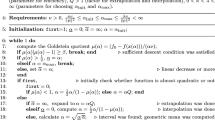Abstract
Let \(\underline s \)(t), 0 ≤ t ≤ T, be a smooth curve and let \(\underline x \) i , i = 1, 2, \( \ldots \), n, be a sequence of points in two dimensions. An algorithm is given that calculates the parameters ti, i = 1, 2, \( \ldots \) , n, that minimize the function max{‖\(\underline x \) i − \(\underline s \) (ti) ‖2 : i = 1, 2, \( \ldots \), n } subject to the constraints 0 ≤ t1 ≤ t2 ≤ \( \cdots \) ≤ tn ≤ T. Further, the final value of the objective function is best lexicographically, when the distances ‖\(\underline x \) i − \(\underline s \) (ti)‖2, i = 1, 2, \( \ldots \), n, are sorted into decreasing order. The algorithm finds the global solution to this calculation. Usually the magnitude of the total work is only about n when the number of data points is large. The efficiency comes from techniques that use bounds on the final values of the parameters to split the original problem into calculations that have fewer variables. The splitting techniques are analysed, the algorithm is described, and some numerical results are presented and discussed.
Similar content being viewed by others
References
I. Barrodale, R. Kuwahara, R. Poeckert, and D. Skea, “Side-scan sonar image processing using thin plate splines and control point matching,” Numerical Algorithms, vol. 5, pp. 85-98, 1993.
L.G. Brown, “A survey of image registration techniques,” Computing Surveys, vol. 24, pp. 325-376, 1992.
J. Flusser, “An adaptive method for image registration,” Pattern Recognition, vol. 25, pp. 45-54, 1992.
M.J.D. Powell, “A thin plate spline method for mapping curves into curves in two dimensions,” in Computational Techniques and Applications: CTAC95, R.L. May and A.K. Easton (Eds.), World Scientific: Singapore, 1996, pp. 43-57.
Author information
Authors and Affiliations
Rights and permissions
About this article
Cite this article
Powell, M. An Optimal Way of Moving a Sequence of Points onto a Curve in Two Dimensions. Computational Optimization and Applications 13, 163–185 (1999). https://doi.org/10.1023/A:1008617208706
Issue Date:
DOI: https://doi.org/10.1023/A:1008617208706




